 |
| About Alan |
| Tutorials |
| Free files |
| Win9x FAQs |
|
|
| |
| Articles |
| BIV articles |
| Archive |
| Other articles |
| Archive |
| |
 |
|
|
Get to Know CD virtually gets Canadian
elementary students out of the classroom
by Alan Zisman (c) 2008 first published in CUE BC Newsletter March 2008 With some regularity, schools get notice of websites and software that, the developers assume, will be of interest to students and teachers- often these are sent to the attention of the principal or the librarian. In my eternal quest to find activities to do with elementary students in my school’s computer lab, I’ve checked out more than my share. Sadly, most of the time, I’m disappointed. In some cases, there’s a lot of content, but it’s poorly presented, or not at a reading level that’s accessible to elementary-age students. In other cases, there are a couple of games—but they’re not very educationally useful and not even very much fun. 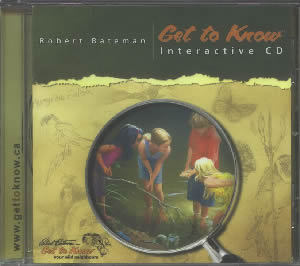 When
I get something new, I ask a few students to try it out and give me
feedback—keep it or lose it, or if it’s too simple for them, what
grades might best appreciate it. Students appreciate that their
feedback is valued, but all too often, their conclusion is ‘lose it’. When
I get something new, I ask a few students to try it out and give me
feedback—keep it or lose it, or if it’s too simple for them, what
grades might best appreciate it. Students appreciate that their
feedback is valued, but all too often, their conclusion is ‘lose it’.Recently, a CD showed up in my box in the office (passed on by my principal), titled “Robert Bateman Get to Know Interactive CD”. There was an accompanying “Dear Principal” letter, with a sidebar naming a long list of corporations and organizations ranging from the Vancouver School Board to Nature Trust of BC to Wal-Mart Canada. In the body of the letter, well-known nature artist Robert Bateman expressed pleasure to work with the Return of the Peregrine Falcon Society and Morningstar Enterprises to create the CD in the hope of connecting “the youth of Canada with their neighbours of other species”. The letter continues to note that the CD “is a gift to your school” and encourages schools “to make copies of the CD to distribute for use at school”. (No, “the CD may not be reproduced for re-sale purposes). And the letter notes their website: www.gettoknow.ca . 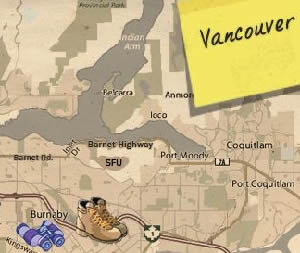 According
to webmaster Rob King, in BC, they “have currently provided 6 school
districts in the Vancouver area with the CD: Vancouver (VSB),
Northshore, Surrey, Delta, Coquitlam, and West Vancouver. There
are plans to provide all schools in the lower mainland with copies of
the CD by this spring.” A limited number of CDs are available for sale
($25) from the website. According
to webmaster Rob King, in BC, they “have currently provided 6 school
districts in the Vancouver area with the CD: Vancouver (VSB),
Northshore, Surrey, Delta, Coquitlam, and West Vancouver. There
are plans to provide all schools in the lower mainland with copies of
the CD by this spring.” A limited number of CDs are available for sale
($25) from the website.When a pair of grade 5s checked it out, they concluded that it wasn’t much of a game, but ‘it might teach kids some stuff’. Worth further exploration, then. The CD is Windows-only (in fact, it wouldn’t run on my Win9x systems), though this isn’t mentioned anywhere- but lacks a Windows auto-run feature. In order to let entire classes make use of the CD at once, rather than make 30 copies of the CD, I copied the contents onto each workstation’s hard drive, manually adding a shortcut to the Start Menu. (Thanks to the tech support person at gettoknow.ca who suggested that, when I emailed that performance dropped to non-usability when more that a couple of people tried to access it at a time across my network). 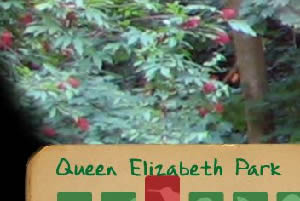 When
the CD starts up, a user gets options to be a teacher or a student;
teachers get access to a set of PDF lesson plans- none of these,
however, directly relate to using the CD. The lesson plans cover a
variety of topics involved in taking a class out on a nature walk-
there’s even a lesson plan on ‘owl pellets’. Useful stuff, but it
suggests a bit of a schizoid nature to this CD—it’s a series of
activities done at a computer that hope to get students and whole
classes to get up from their computers and go out and explore the
natural world around them. Webmaster Rob King noted: “The true aim in
the production of the CD is to get more students outdoors experiencing
nature.” When
the CD starts up, a user gets options to be a teacher or a student;
teachers get access to a set of PDF lesson plans- none of these,
however, directly relate to using the CD. The lesson plans cover a
variety of topics involved in taking a class out on a nature walk-
there’s even a lesson plan on ‘owl pellets’. Useful stuff, but it
suggests a bit of a schizoid nature to this CD—it’s a series of
activities done at a computer that hope to get students and whole
classes to get up from their computers and go out and explore the
natural world around them. Webmaster Rob King noted: “The true aim in
the production of the CD is to get more students outdoors experiencing
nature.”Log in as a student and you’re asked to provide a name, then choose a location: Vancouver, Calgary, Edmonton, or Toronto. Hiking boot icons lead to a total of 24 hikes are available, 6 for each location. (Hikes include several in the city and others in the surrounding municipalities); magnifying glass icons link to websites for nature-related organizations.
Kudos
to the gettoknow.ca people for developing this CD, for distributing it
for free to many schools, and for allowing schools to copy and install
it as needed. (I wish they had come up with a better name, though!) |
|
Alan
Zisman is a Vancouver educator, writer, and computer
specialist. He
can be reached at E-mail
Alan
|
|
|
| |

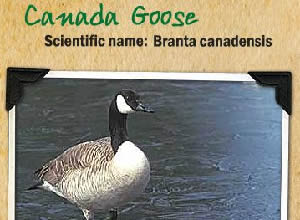 Each
‘virtual hike’ asks users to use their mouse to move around a 360
degree landscape, looking for 10-11 plants and animals typically found
in that ecosystem. When your mouse points to one of these species, a
silhouetted thumbnail jumps up, letting you know that you’ve found it.
Clicking on it reveals a page with scientific name, information,
photos, video and sound clips for that species. Find all the species on
a hike and you can take a quiz—score 8 or more (out of 10 questions)
and get points towards virtual bonus prizes.
Each
‘virtual hike’ asks users to use their mouse to move around a 360
degree landscape, looking for 10-11 plants and animals typically found
in that ecosystem. When your mouse points to one of these species, a
silhouetted thumbnail jumps up, letting you know that you’ve found it.
Clicking on it reveals a page with scientific name, information,
photos, video and sound clips for that species. Find all the species on
a hike and you can take a quiz—score 8 or more (out of 10 questions)
and get points towards virtual bonus prizes.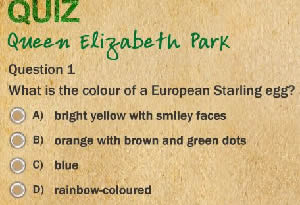 It’s
not perfect—the mouse disappears with some regularity (move around to
the bottom of the screen then up to bring it back—most of the time!
When that doesn’t work, students have had to close the program, start
up, and log in again- luckily it keeps track of the species already
identified.
It’s
not perfect—the mouse disappears with some regularity (move around to
the bottom of the screen then up to bring it back—most of the time!
When that doesn’t work, students have had to close the program, start
up, and log in again- luckily it keeps track of the species already
identified.